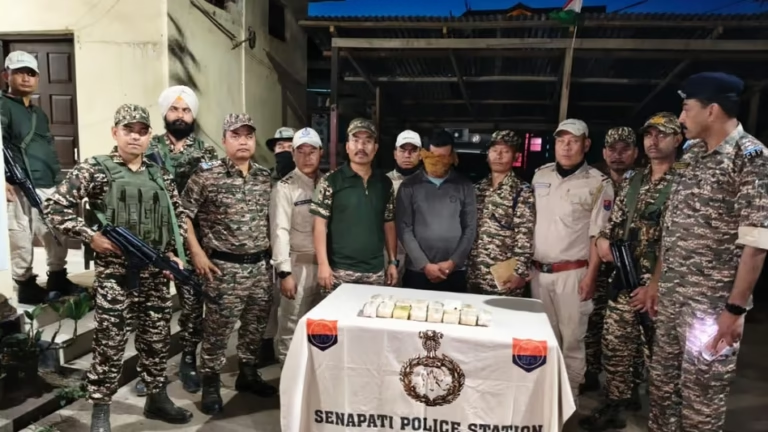Naga Village Chief and Foreign Minister Oppose Indo-Myanmar Border Fencing: A Controversial Issue of Sovereignty and Identity
Summary of the News Article
The Indo-Myanmar border fencing issue has sparked significant opposition from Naga village chiefs and Manipur’s Foreign Minister. They express concerns that the fencing will divide traditional Naga lands and disrupt the socio-cultural ties shared by communities on both sides of the border. This border demarcation is seen not just as a territorial issue, but also as a threat to the identity, history, and autonomy of indigenous Naga people.
Introduction: A Border that Divides More Than Just Land
The border between India and Myanmar stretches over 1,600 kilometers, but it’s more than just a line on a map. For the Naga people, who have lived on both sides of the border for centuries, this demarcation is an existential issue. They’ve long seen the Indo-Myanmar border as an artificial divide imposed by external governments that does not reflect their historical, cultural, or geographical realities.
Recently, the Indian government’s plan to fence portions of this border has sparked outrage and resistance from Naga leaders, particularly village chiefs and the Foreign Minister of Manipur. This article explores the deep concerns around the border fencing project and its potential impact on the Naga people’s identity, sovereignty, and livelihood.
Historical Context: The Naga People and Their Land
A Shared Identity Across Borders
The Naga people are an indigenous ethnic group spread across northeastern India and northwestern Myanmar. Before the imposition of modern national borders, these communities shared a common culture, language, and way of life, with their lands overlapping the current boundaries of both countries.
For the Naga people, the Indo-Myanmar border has never been a rigid divide. Rather, it has been a shared landscape, where families, clans, and tribes move freely, trading, farming, and maintaining their cultural ties. The proposed fencing project, however, threatens to disrupt this delicate balance.
Colonial Legacies: A Border Imposed
The current border between India and Myanmar is largely the result of colonial-era demarcations. When the British Empire left the region, they drew borders that did not account for the complex ethnic and cultural diversity of the local populations. The Naga people were split between two countries, with their lands divided arbitrarily.
This division has remained a source of tension ever since. Over the decades, there have been multiple insurgencies and movements among the Naga people, demanding greater autonomy or even independence. For many Nagas, the fencing project feels like a continuation of this colonial legacy—an imposition on their lands and identity.
The Fencing Project: What’s at Stake?
Government’s Perspective: Border Security and Control
From the Indian government’s perspective, the fencing project is primarily about national security. The Indo-Myanmar border is porous, with people moving freely between the two countries. This has raised concerns about illegal immigration, smuggling, and the movement of insurgent groups across the border.
To address these security concerns, the Indian government has proposed fencing certain portions of the border to create more controlled entry points. The goal is to regulate cross-border movements and prevent unlawful activities.
Naga Concerns: Cultural and Social Disruption
For the Naga people, however, the fencing project is not just a matter of border security—it’s an existential threat. The Naga leaders, particularly village chiefs and community elders, are deeply concerned that the fence will divide their ancestral lands, cutting off families, clans, and tribes who have lived on both sides of the border for generations.
The fence would disrupt the free movement of people, goods, and livestock, affecting not just daily life but also the cultural and social fabric of the Naga community. Traditional rituals, festivals, and even funerals often involve family members from both sides of the border, and the fencing could severely restrict this cross-border interaction.
Voices of Opposition: Naga Village Chiefs and the Manipur Government
Village Chiefs Take a Stand
The Naga village chiefs, who hold significant authority within their communities, have been vocal in their opposition to the border fencing. For them, the fence is not just a political or administrative issue—it’s a violation of their ancestral rights and autonomy.
Many village chiefs argue that the fence would not only divide their lands but also undermine the centuries-old governance structures of the Naga people. They’ve historically managed their own territories with little interference from external governments, and the fence is seen as a direct challenge to this autonomy.
Manipur’s Foreign Minister Weighs In
Manipur’s Foreign Minister has also expressed concerns about the fencing project. He emphasized that the Naga people’s unique history and cultural identity should be respected and that any attempt to divide their lands would only lead to further tension and unrest.
The Foreign Minister called for a more consultative approach, suggesting that the government should engage in dialogue with Naga leaders and communities before moving forward with the project. He warned that the fencing could have long-term social and political consequences if not handled carefully.
The Broader Implications: What Does This Mean for Naga Identity?
A Threat to Traditional Governance and Autonomy
For the Naga people, the fencing project represents a broader threat to their traditional governance structures and autonomy. The Naga tribes have long managed their own affairs through a system of village councils, where chiefs and elders play a central role in decision-making.
By imposing a rigid border between India and Myanmar, the fencing project undermines this system of self-governance. It imposes an external authority on the Naga people, potentially eroding their cultural and political autonomy.
A Cultural and Historical Disruption
The Indo-Myanmar border fencing could also have a profound impact on the Naga people’s cultural and historical connections. Many Naga clans are spread across both sides of the border, and their shared history is an essential part of their identity.
Cutting off these connections would not only disrupt the daily lives of the Naga people but also threaten their cultural heritage. Traditional rituals, festivals, and other cultural practices often involve family members from both sides of the border, and the fence could make these practices difficult, if not impossible.
Environmental and Economic Impact: Beyond the Cultural Divide
Disrupting Livelihoods
In addition to the cultural and social implications, the fencing project could have a significant economic impact on the Naga people. Many Naga communities rely on cross-border trade and farming, and the fence could severely restrict their ability to access resources and markets.
For instance, many Naga families have farms that straddle both sides of the border. The fence would effectively divide these farms, making it difficult for farmers to access their land and livestock. This could lead to a decline in agricultural productivity, exacerbating poverty and food insecurity in the region.
Environmental Concerns
The Indo-Myanmar border region is also home to a rich and diverse ecosystem. The construction of the fence could disrupt wildlife habitats and lead to deforestation, further threatening the region’s biodiversity. Environmentalists have raised concerns that the fence could have long-term ecological consequences, particularly for endangered species that rely on cross-border habitats.
The Path Forward: Dialogue and Diplomacy
Engaging with Naga Leaders
Given the widespread opposition to the fencing project, it’s clear that any solution must involve dialogue and consultation with the Naga people. The government cannot simply impose the fence without considering the views of the communities it will affect.
By engaging with Naga village chiefs, community leaders, and local governments, the Indian government can develop a more nuanced and respectful approach to border security. This could involve alternative measures, such as strengthening existing cross-border agreements or creating designated crossing points that allow for continued cultural and economic exchange.
Balancing Security and Sovereignty
Ultimately, the challenge lies in balancing the government’s security concerns with the Naga people’s rights to their land and culture. The Indo-Myanmar border fencing project is a complex issue that requires careful consideration of both sides.
FAQs
- Why are Naga village chiefs opposed to the Indo-Myanmar border fencing?
Naga village chiefs are opposed to the fencing because it threatens to divide their ancestral lands, disrupt their cultural practices, and undermine their traditional governance systems. - What is the government’s justification for the border fencing?
The Indian government argues that the fencing is necessary for national security, particularly to prevent illegal immigration, smuggling, and insurgent movements. - How will the fence impact the daily lives of the Naga people?
The fence could disrupt cross-border trade, farming, and cultural exchanges, making it difficult for Naga families and communities to maintain their way of life. - What are the environmental concerns associated with the fencing project?
The fence could lead to deforestation and disrupt wildlife habitats, posing a threat to the region’s biodiversity and ecosystem. - Is there a potential solution to the conflict?
A potential solution could involve dialogue between the government and Naga leaders, with a focus on finding alternative ways to secure the border without dividing Naga communities.



